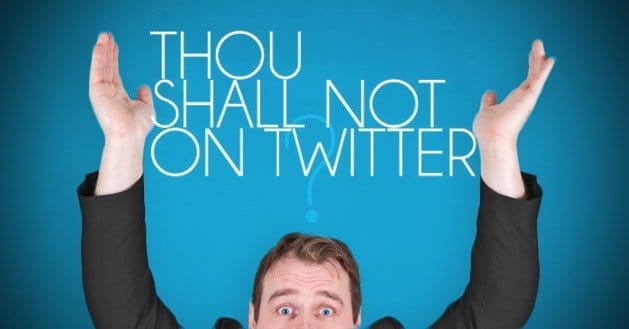 Written by ContentPowered.com
Written by ContentPowered.com
Twitter, when done properly, looks effortless. That said, it’s incredibly easy to do something wrong, show your lack of familiarity with the platform and its culture, and make it obvious you’re only using the site for marketing. To help avoid that, learn and remember these Twitter etiquette rules.
Don’t Post Mundane Banality
The content of your tweets is important. Avoid posting anything your users won’t want to see. In particular, avoid the mundane little things like your meals or your experiences on the morning commute. Before you tweet, ask yourself, “As a user, is this something interesting to me?” If not, don’t post the tweet. The only exceptions are, for example, if a meal post might tie in to an ongoing ad campaign or promotion you’re running.
Don’t Post TMI
TMI, or Too Much Information, is just stuff no one wants to hear. As a business owner or blogger, no one wants to hear about your medical conditions, bowel movements or baby’s first steps. Keep that to your inane texts to friends at three in the morning. You want to humanize yourself with your social presence, but you don’t want to go quite that far.
Don’t Post Media Spoilers
Yes, it’s important to connect with your audience. One great way to connect is through a common bond of popular culture. That doesn’t mean you’re free to assume everyone has experienced the same media you have. Avoid trying to connect by posting modern media spoilers. If you were really invested in seeing Star Wars for the first time, you wouldn’t want to sign on to Twitter and see your favorite brand post “OMG that reveal that Vader is Luke’s father was nuts!” Don’t do that to your fans.
Don’t Be Too Promotional
An inexperienced business promoting on Twitter for the first time is almost always going to make the mistake of centering every tweet around self-promotion. Yes, you have a blog and a business you want to promote. No, you shouldn’t include it in ever message you post. Instead, intersperse your promotional posts within a stream of shared content and replies to public messages.
Don’t Be Confrontational
A controversy or a confrontation can be a good way to drum up a lot of publicity, but chances are it’s almost always going to be negative. You’re not a celebrity, you can’t start a Twitter feud and get away with it. You can’t lash out publicly against users or competitors. You shouldn’t even take a political stance, if possible. Controversy and confrontation destroy brands.
Minimize Hashtag Use
Hashtags are incredibly important for making sure your tweets are seen. They’re also difficult to use properly. It can be very tempting to spam a list of them each time you tweet, even going so far as to tweet a second time just to include more hashtags. Don’t do this. Limit yourself to 1-3 relevant hashtags for each tweet.
When you’re using hashtags – and you should be – you need to use them properly. Keep them relevant and, whenever possible, don’t make them up. Check a tag before you use it to see what the ongoing conversation is. The only times you should make up a hashtag are when you’re creating an intentionally ridiculous tag for the sake of humor (#OverlyLongHashtagsOnCharacterLimitedMedia) or you’re creating a branded tag specifically for an advertising campaign or contest.
Always use hashtags. It’s easy to stick one tag on the end of basically any message, and it makes your message part of a larger whole. If you’re skipping the hashtag, you’re limiting your audience.
Post Frequently
Buffer’s social media frequency guide is often cited because it’s a very detailed study. Buffer is a large brand with a sizable following, and gets away with posting over a dozen times every day. Smaller brands with smaller audiences should dial that back, to avoid being labeled a spammer.
Don’t Post Too Frequently
Twitter’s business best practices advise you to shoot for between 3-5 tweets per day. This helps you avoid the spammer label, and it allows you the flexibility to be more timely with your tweet content. You don’t have to make a harsh decision between turning off a scheduled tweet or posting a compelling message about breaking news.
Warn Incoming Livetweet Events
Livetweeting is a great way to give breaking news to your users. It’s generally used for conventions and events, where posting immediate news is a good idea. However, if a user tunes in midway through the event, they’re going to be flooded with contextless tweets. Warn your users when you’re going to livetweet and, if possible, create a special hashtag for the event and your feed.
Follow Selectively
If you follow everyone you come across, you look desperate to your users. If you reciprocally follow everyone who follows you, people will use you to inflate their follower counts. You also lose out on any value from your followed stream, in the crush of information. Be selective with who you follow and try to limit it to brand influencers and powerful people.
Use @Mention Whenever Possible
Mentioning a user without the @ doesn’t notify that user of the content. Brands can use social listening to find those mentions, but it’s harder and doesn’t get you a quick response. Only use it if you don’t want the user to respond quickly, if at all. In any instance where you want a response, use the @mention.
Respond to @Mentions and DMs
When a user @mentions you, it means they want you to see and respond to their message. Do so. If you’re not responsive, you’re not being social on this social media platform. Direct Messages are also messages you should respond to, though you should always do it privately. If a user sent you a private message, respect that privacy.
Lean the Difference Between Retweets
There are two forms of retweet; manual and automatic. The automatic retweet is a click of a button. Use it when you want your users to see the original tweet, unaltered, from the original user. A manual retweet is when you copy and paste an original tweet. RT: @user “Original Tweet Content Here” [Added Commentary] is the general format. Use it when you want to add your own comment to a tweet while still sharing the original content.
Limit Automation to Scheduling
If you automate responses to @mentions, direct messages or follows, you’re going to look like your account is run by a robot. The same goes for any form of automatically generated message. The only automation you should use on Twitter is a post scheduler, and even then you should be active in case a user comes up with a question or comment when your tweet goes live.


